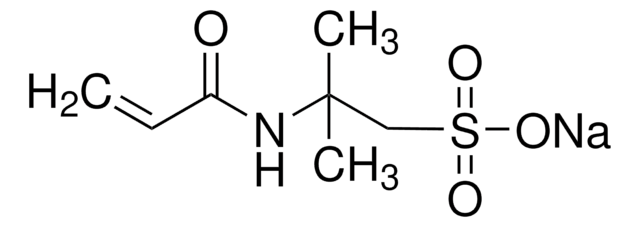278424
Poly(vinylsulfonic acid, sodium salt) solution
30-40 wt. % in H2O, technical grade
Synonym(s):
PVSA
Sign Into View Organizational & Contract Pricing
All Photos(1)
About This Item
Linear Formula:
(C2H3NaO3S)n
CAS Number:
MDL number:
UNSPSC Code:
12162002
PubChem Substance ID:
NACRES:
NA.23
Recommended Products
grade
technical grade
Quality Level
form
liquid
concentration
30-40 wt. % in H2O
refractive index
n20/D 1.389
density
1.267 g/mL at 25 °C
SMILES string
[Na]OS(=O)(=O)C=C
InChI
1S/C2H4O3S.Na/c1-2-6(3,4)5;/h2H,1H2,(H,3,4,5);/q;+1/p-1
InChI key
BWYYYTVSBPRQCN-UHFFFAOYSA-M
Related Categories
Application
Poly(vinylsulfonicacid, sodium salt) (PVSA) can be used:
- In the preparation of superabsorbent semi-IPN (interpenetrating polymer network) hydrogel.
- As a solid electrolyte for proton conduction in the fabrication of an all-solid-supercapacitor.
- As a crystallization controlling agent in the preparation of high-quality crystals of porous coordination polymers(CP). PVSA regulates not only the size and structure of the crystals but also their preference orientation, resulting in CP channel alignment in the bulk powdery state.
Signal Word
Warning
Hazard Statements
Precautionary Statements
Hazard Classifications
Eye Irrit. 2 - Skin Irrit. 2 - STOT SE 3
Target Organs
Respiratory system
Storage Class Code
10 - Combustible liquids
WGK
WGK 3
Personal Protective Equipment
dust mask type N95 (US), Eyeshields, Gloves
Choose from one of the most recent versions:
Already Own This Product?
Find documentation for the products that you have recently purchased in the Document Library.
Customers Also Viewed
Krasimir Vasilev et al.
Nanotechnology, 21(21), 215102-215102 (2010-05-01)
This paper presents a novel and facile method for the generation of efficient antibacterial coatings which can be applied to practically any type of substrate. Silver nanoparticles were stabilized with an adsorbed surface layer of polyvinyl sulphonate (PVS). This steric
A Gambhir et al.
Applied biochemistry and biotechnology, 96(1-3), 303-309 (2002-01-11)
The article describes the adsorption characteristics of DNA onto electrochemically generated polypyrrole-polyvinyl sulfonate (PPY-PVS) films obtained as a function of pH. Adsorption on PPY doped with an anion proceeds by anion exchange, and since DNA possesses a fixed negative charge
Jitka Caslavska et al.
Electrophoresis, 27(23), 4618-4630 (2006-12-01)
Bidirectional ITP in fused-silica capillaries double-coated with Polybrene and poly-(vinylsulfonate) is a robust approach for analysis of low-molecular-mass compounds. EOF towards the cathode is strong (mobility >4.0 x 10(-8) m(2)/Vs) within the entire pH range investigated (2.40-8.08), dependent on ionic
Yuejuan Cai et al.
Frontiers in bioscience : a journal and virtual library, 12, 1946-1955 (2006-11-28)
In pH 6.0 phosphate buffer solutions (PBS), a glassy carbon electrode (GCE) modifying by nano-tin oxide/polyvinyl sulfonic potassium (nano-SnO2/PVS) exhibited an enhanced effectiveness for the oxidation of ciprofloxacin (CFX), which compared with a bare GCE or a nano-SnO2 modified electrode.
Paul McDonald et al.
Biotechnology and bioengineering, 102(4), 1141-1151 (2008-11-26)
We evaluated the potential for polyelectrolyte induced precipitation of antibodies to replace traditional chromatography purification. We investigated the impact of solution pH, solution ionic strength and polyelectrolyte molecular weight on the degree of precipitation using the anionic polyelectrolytes polyvinylsulfonic acid
Our team of scientists has experience in all areas of research including Life Science, Material Science, Chemical Synthesis, Chromatography, Analytical and many others.
Contact Technical Service












